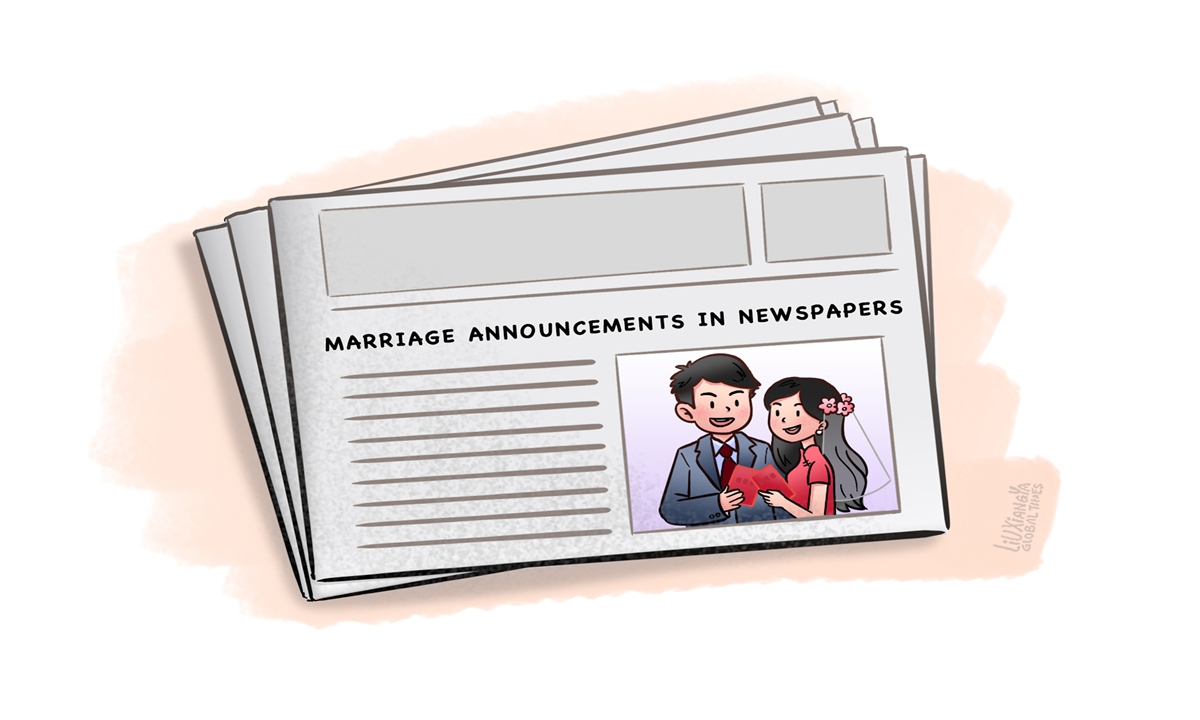
Illustration: Liu Xiangya/GT
What was once a formal way of announcing nuptials is now being seen as a romantic and retro-inspired expression of love and commitment. Publishing marriage announcements in newspapers has gained in popularity among young Chinese couples, reflecting not only a renewed appreciation for traditional rituals but also a modern reinterpretation of them.
In the digital age, many young people tend to share marriage announcements on social media platforms like Sina Weibo, China's equivalent of X, or WeChat, an instant messaging mobile app. Yet a new trend has reemerged - publishing marriage announcements in traditional newspapers. This practice has gained attention on Chinese social media, earning praise for its blend of ritualistic significance and its value as a meaningful and lasting commemoration of a couple's union.
A quick search on the topic "publishing marriage announcements in newspapers" will bring up various guides, along with those who have done so sharing their experiences. In response to new demand, many daily and evening newspapers across the country have introduced marriage announcement services, with several also offering personalized designs.
Unlike fleeting digital posts, newspaper announcements provide a sense of permanence and tangibility, offering a meaningful way to preserve memories during a time when digital content often lacks durability. Some young people view publishing marriage announcements in newspapers as more formal than that in social media, and they describe it as a commitment written in black ink and on white paper - a declaration of the couple's promise to grow old together.
However, publishing marriage announcements in newspapers is not a new phenomenon in China. During the Republica of China era (1912-49), when marriage laws and registration systems were still underdeveloped, such announcements carried legal significance. They became a popular practice, allowing couples to publicly share their joyous news and celebrate their union with their family and friends, according to the Xinhua News Agency.
According to a report by the Beijing Daily on Monday, after China's reform and opening-up conducted in late 1978, promoting simplicity in weddings gained traction, and many couples used newspapers to reflect this trend. Years ago, the Shanghai Library used its collections to locate a marriage announcement from half a century ago for a netizen's grandparents. This discovery allowed the elderly couple to relive their cherished memories.
"This practice adds a stronger sense of ceremony due to its unique commemorative value," Ma Jianwen, a registered counselor of the China Association for Mental Health and director general of the Aijia Institute of Psychology in South China's Guangdong Province, told the Global Times.
Traditionally, major events or declarations were announced in newspapers, and reviving this method has turned it into a personalized way to declare a marriage. Publishing in an official newspaper not only symbolizes a public commitment, gaining recognition and blessings but also highlights identity and role transitions in life, such as becoming a spouse. It also serves as a form of social supervision, emphasizing social and moral responsibilities within marriage, added Ma.
What sets this modern revival apart is the personal touch young couples bring to these announcements. Today's announcements often feature customized designs, poetic language, and even nostalgic elements inspired by classical Chinese literature. These artistic expressions transform the announcements into deeply personal artifacts that blend cultural heritage with individuality, showing that tradition and self-expression are not mutually exclusive but can beautifully coexist.
Moreover, this trend has strengthened the connection between print media and younger generations. Local newspapers now offer customized services to meet their growing demand, demonstrating how traditional media can adapt by embracing modern cultural trends. Accessible online tools through platforms like Alipay and WeChat make creating and publishing announcements simple, encouraging younger audiences to adopt this nostalgic practice.
"In today's digital age, information is fragmented and fast-paced, but newspapers allow us to slow down. Young people choosing this medium may seek a lifestyle rooted in tradition and ritual. Their preference reflects a longing for meaningful and ceremonial practices that bring a sense of connection to the past while embracing a retro and deeply personal way of celebrating significant milestones," said Ma.
The rise of marriage announcements in newspapers also reflects broader trends in how millennials and Gen Z approach weddings. Today's young couples are increasingly favoring minimalistic and meaningful ceremonies over extravagant celebrations. As the main demographic driving the practice, the "post-1990" and "post-2000" generations value authenticity and simplicity, often seeking creative ways to commemorate their big day without succumbing to social pressures toward lavishness.
"Young Chinese people's perspectives toward weddings have indeed become more diverse and inclusive in recent years. They are moving away from traditional concepts and forms of weddings, focusing more on the essence and meaning of marriage," said Ma.
Publishing a marriage announcement aligns perfectly with these values. As an alternative to materialistic wedding trends, it is a relatively low-cost yet elegant gesture, providing an opportunity for young people to publicly celebrate love in a way that feels both unique and timeless.
The renewed popularity of marriage announcements in newspapers among young Chinese couples is more than a trend. It shows how tradition can adapt to modern times. By combining cultural heritage with personal creativity, it offers meaningful rituals in today's digital world. This trend also highlights how newspapers can stay relevant by embracing change. These announcements, as symbols of love and individuality, remind us that some traditions are worth preserving.
The author is a reporter with the Global Times. life@globaltimes.com.cn




